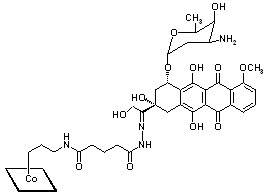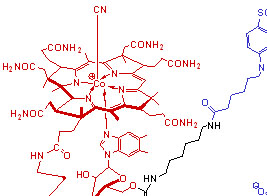Charles B. Grissom
 BIOORGANIC CHEMISTRY
BIOORGANIC CHEMISTRY
Professor
B.A., 1981, University of California, Riverside
Ph.D., 1985, University of Wisconsin
NIH Postdoctoral Fellow, 1987-89, University of California, Berkeley.
Phone: (801) 581-4153
Office: 1128 HEB-N
Email: grissomc@chem.utah.edu
Research Group
Activities & Awards
- Program Leader,Molecular Imaging and Diagnostic Therapeutics Program of the Huntsman Cancer Institute NIH Cancer Center, 2006-present
- Stoel-Rives Innovation Award in Medical Diagnostics, 2006
- Biotechnology Track Director, Univ. Utah Masters in Sci. & Technol. Program, 2005-present
- Director, Interdepartmental Program in Biological Chemistry 2002-2004
- William W. Epstein Outstanding Educator Award, April 2000
- Chairman, Gordon Conference on Enzymes, Coenzymes, and Metabolic Pathways, 1999
- Executive Committee, ACS Younger Chemists Committee, 1985-94
Research Interests
Targeted Delivery of Cancer Drugs. Our laboratory has developed a new method to target the delivery of cytotoxic anticancer drugs and fluorescent tumor imaging agents to tumor cells by using vitamin B12 as a "Trojan Horse" delivery vehicle.

Drug-B12 bioconjugates are synthesized by attaching various cytotoxic warheads to cobalamin. The pro-drug is nontoxic until it reaches its intracellular target and undergoes enzymatic activation. Our results in vitro and in vivo show this strategy for targeted drug delivery to be a very effective method to increase the therapeutic index of existing anticancer drugs. Rapidly dividing cells require coenzyme B12 for thymidine synthesis prior to DNA replication. Elevated levels of cobalamin and cobalamin transport proteins are observed in many patients with leukemia and various solid tumors.
Cancer Diagnostics and Fluorescent Imaging Agents. A fluorescent conjugate of cobalamin (CobalaFluor®) that we developed is being evaluated as an imaging agent for breast cancer surgery and other diagnostic procedures where it is desirable to visualize tumors and metastatic cancer cells. Accompanying instrumentation has been developed that may allow axillary lymph node dissection in breast cancer surgery to be carried out with minimally-invasive endoscopic techniques.

We are also using CobalaFluor® to explore the intracellular trafficking of cobalamin as it enters the cell and is transported through the lysosome to the cytosol. In collaboration with the Harris laboratory, we have visualized single molecules of fluorescently-labeled cobalamin in endosomes as they are moved along microtubules in cells.
Projects for Graduate Students. Graduate students have the ability to define their own project within the spectrum of cobalamin-targeted drug delivery. Students can design, synthesize, and test new bioconjugates of cancer drugs. Since this project is a collaboration with research groups in the Chemistry, Pharmacology, Pathology, and Surgery Departments of the University of Utah Medical School, students can participate in every aspect of therapeutic drug development and biological evaluation. This unusual opportunity in an academic setting provides a broad graduate education, with solid training in biological chemistry.
Vitamin B12 Dependent Enzymes and Magnetic Field Effects on Electron Transfer.Our laboratory is also studying the mechanism of enzymes with radical pair intermediates, especially B12-dependent enzymes. We have developed new methods for probing the mechanism of biological and chemical reactions using magnetic fields and heavy atoms. Only reactions that produce a radical pair intermediate are influenced by an external magnetic field or a heavy atom (such as xenon). We reported the first magnetic field effect on an enzymatic reaction (B12 dependent ethanolamine ammonia lyase). This finding is significant because it confirms the existence of a inetically-significant radical pair intermediate in enzymatic catalysis and it provides a mechanism by which magnetic fields can interact with specialized biological systems. We have extended our studies to horseradish peroxidase, a heme-containing enzyme that is also magnetic field dependent.
Selected Publications
- Afanasyeva, M. S.; Taraban M. B.,; Polyakov, N. E.; Purtov, P. A.; Leshina, T. V. ; Grissom, C. B. “Elementary Steps of Enzymatic Oxidation of Nifedipine Catalyzed by Horseradish Peroxidase.” J. Phys. Chem. B., 2006, 110, 21232-21237.
- Afanasyeva, M. S.; Purtov, P. A.; Taraban M. B.; Leshina, T. V. ; Grissom, C. B. “Photoinitiated Oxidation of NADH Catalyzed by Horseradish Peroxidase Studied by Chemically-Induced Dynamic Nuclear Polarization.” Russian Chemical Bulletin, International Edition, 2006, 55, 1-5.
- Fedosov, S. N.; Grissom, C. B.; Fedosova, N. U.; Moestrup, S. K.; Nexo, E.; Petersen, T. E. “Application of a Fluorescent Cobalamin Analogue for Analysis of the Binding Kinetics.” FEBS Journal,2006, 273, 4742-4753.
- Afanasyeva, M. S.; Taraban M. B.; Purtov, P. A.; Leshina, T. V.; Grissom, C. B. “Magnetic Spin Effects in Enzymatic Reactions: Radical Oxidation of NADH by Horseradish Peroxidase.”, J. Am. Chem. Soc. 2006, 128, 8651-8658.
- Horton, R. A.; Bagnato, J. D.; Grissom, C. B. "Synthesis and Characterization of a Cobalamin- Colchicine Conjugate as a Novel Tumor-Targeted Cytotoxin", J. Org. Chem. In Press (2004).
- McGreevy, J. M.; Cannon, M.; Grissom, C. B. "Minimally-Invasive Nodal Dissection in Pigs using Fluorescently-Labelled Cobalamin", J. Surg. Res., 111: 38-44, (2003).
- Horton, R. A.; Bagnato, J. D.; Grissom, C. B. "Structural Determination of 5'-OH a-Ribofuranoside Modified Cobalamins via 13C and DEPT NMR", J. Org. Chem . 68:7108-7111, (2003).
- MJ Cannon, DG Myszka, JD Bagnato, DH Alpers, FG West, CB Grissom, Affinity and Kinetic Analysis of the Interactions between Vitamin B12 Binding Proteins and Cobalamins by Surface Plasmon Resonance, Analytical Biochemistry, 305:1-9. (2002).
- MA Anderson, Y Xu, CB Grissom, (2001) Electron Spin Catalysis by Xenon in an Enzyme. J.Am. Chem . Soc. 123:6720-6721.
- C Smeltzer, MJ Cannon, P Pinson, JS Munger, FG West, CB Grissom, Synthesis and Characterization of Fluorescent Cobalamin (CobalaFluor) Derivatives for Imaging . Org. Lett ., 3: (2001) 799-801.
